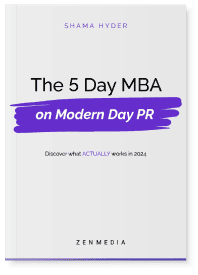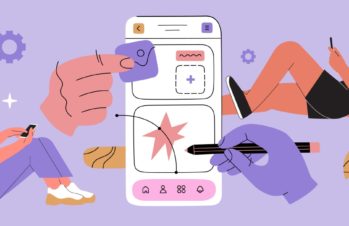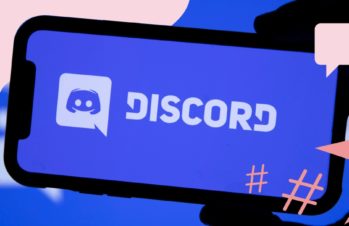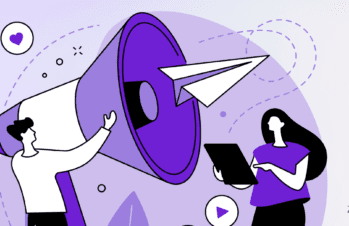If your audience can’t see you, they can’t choose you. They need to know who you are and what you do. Only then will they be compelled to search for you, follow you, and engage with your content. Brands need to give audiences the types of content they want to consume without requiring them to talk to a salesperson.
So, how can B2Bs manage all that? Simple, demand generation.
What is B2B demand generation?
B2B demand generation is an integrated marketing communications strategy that aims to drive awareness of and interest in a brand’s products and services. Demand generation targets qualified leads through education, addressing consumer pain points, and offering solutions to those pain points.
The goal of demand generation is, quite simply, to generate demand! This is accomplished by building brand awareness and developing a captive audience who engages with your brand by consuming your content, engaging on social media, and more. Ultimately, demand generation should produce more qualified leads and convert more of those leads into customers. It’s a cross-silo effort from marketing, sales, product development, and more, and it can include tactics like:
- Email marketing
- E-books
- Thought leadership
- Brand messaging
- Content marketing
- Press releases
- Social media marketing
- Influencer collaborations
- Webinars
Out of all these tactics and more, 79% of marketers say email is the most effective tactic for demand generation. However, as with all forms of marketing, differentiation is crucial, and brands should employ a variety of tactics to meet goals more efficiently.
Related reading: The Demand Generation: What It Is and Why You Want to Be A Part of It
Demand Generation Versus Lead Generation
So if demand generation is instilling interest in a brand’s products or services, what’s the difference between that and lead generation?
While demand generation is all about creating awareness, interest, and demand for your products or services, lead generation is focused on identifying potential customers and nurturing a relationship with those prospects.
So why shouldn’t businesses place all their focus on finding and targeting leads? Well, did you know that 80% of new leads never actually translate into sales? Part of demand generation is helping people really understand your business, your products and services, your value system, and your mission. The more people are aware of and understand your brand, the more effectively you can implement a lead generation strategy to “capture” that demand.
So, in the long-term view, B2B brands need demand generation strategies that create a groundswell of interest so that when marketers and sales teams employ lead generation strategies, it’s like (qualified) fish in a barrel.
Related Reading: 9 Key Lead Generation Strategies for SaaS Companies
Benefits of Demand Generation
When companies invest in generating demand alongside generating leads, they are sure to see a number of positives, including:
- Higher-quality Leads
- Lower Acquisition Costs
- Increased Retention
- Increased Revenue
To execute a demand generation strategy well, companies need to have a presence where their target audience is (most often social media, with LinkedIn and Twitter being key for B2Bs), they need to be easily searchable, and they need to have a wealth of informative content that runs the spectrum from the basics of what they do and who they are, to the specifics of each component of their product or service, to how their product or service is used in certain industries, what their belief system is in regards to CSR, who their leadership is, and more.
The key to a strong demand gen strategy is to go beyond creating awareness. Strong demand generation marketing includes informing and educating your audience, engaging with them, and giving them the resources to learn more about your brand if they so choose. Then, if they become a lead, they will have already interacted with your brand in a number of ways before reaching a salesperson, meaning your sales reps only interact with truly qualified prospects, lowering your acquisition cost along the way.
B2B Demand Generation 101
Demand Generation Strategies
Create and share high-quality content.
High-quality content is the crux of any good demand generation strategy. B2B buyers can be anywhere from 57% to 70% through the sales cycle before a salesperson is ever involved. Because they get most of their information online—and are making most of their decision, if not entirely making up their mind—before speaking with a salesperson, brands must have high-quality, valuable content that anticipates prospects’ needs and wants and has answers and solutions prepared.
Use thought leadership to spark conversations.
Thought leadership is one facet of high-quality content that brands can use in their demand gen strategies, but it is also a strategy in and of itself. Leveraging thought leadership to spark conversations about your prospects’ biggest pain points, interests, or ideas in your industry is a great way to build personal connections, which is the necessary first step toward investing in a long-term relationship with that prospect.
Have a consistent social media presence.
Social media is key for building awareness and starting conversations. A strategic and creative social media marketing strategy may mean targeting your audience through paid ads and keeping them informed and engaged through an active organic social media strategy. Beyond getting in front of your audience, social media is also a great way to get feedback from your audience and learn about what they’re interested in, what their pain points are, and what resonates. Through social listening, you can identify key conversations in your industry and strategize how you can put your brand in the middle of them.
Partner with influencers.
Looking to get your brand in front of tens of thousands of eyes along with a recommendation from someone that the audience already trusts? Try influencer marketing. Influencer marketing accomplishes the brand awareness component by broadcasting your brand to an already-engaged audience. On top of that, because the audience already enjoys your influencer partner, they are more likely to heed the influencer’s review or recommendation—giving your brand automatic brand awareness and credibility.
Related Reading: Influencer (Creator) Marketing for B2B: A Guide for Those Just Getting Started – Zen Media
Demand Generation KPIs
With any new marketing strategy, it’s important to identify the must-measure KPIs. What metrics will tell you how your new campaign is performing? In order to assess and pivot your demand generation strategies, you must know your best acquisition channel as well as buyer intent and buyer closing data.
Marketers can define their brand’s best acquisition channel by tracking the number of marketing qualified leads (MQLs) and sales qualified leads (SQLs) per channel and the close rate of prospects per channel. This, of course, is done after deals have been closed (some of them, anyway).
Buyer intent data, however, indicates to marketers where prospects are in their journey—evaluating their actions online with your content, products, competitors, events, influencers, and more. The post-sale data here is closing data. In other words, why did the sale close? Buyer intent data shows you where your prospect is in the sales journey, but knowing why they chose your product, what made them decide when they decided, and other qualitative questions can paint a picture of your customer acquisition journey that you may never have seen before. Then, you can take that data and interweave it with the knowledge of your brand’s best acquisition channel for a seamless strategy.
2024 B2B Demand Generation Trends
Personalize at scale through AI
While AI and automation remain crucial, the focus for 2024 should be on leveraging AI to deliver hyper-personalized content at scale. Building on the momentum from previous years, where 39% of marketers recognized automation as a key initiative, AI’s role has expanded from a facilitator of efficiency to a creator of unique customer experiences.
AI can analyze customer data to create highly targeted content that resonates with each segment of the audience, thus driving engagement and demand. This means that AI systems will not only identify patterns in customer behavior but also predict future needs and preferences. By doing so, they empower brands to create content that addresses the specific concerns, desires, and interests of their prospects, dynamically adapting the messaging as the relationship with the customer evolves.
AI can even be used to personalize media pitches and evaluate your press releases. Zen Media’s PR tool, Snooze or News, can be used for demand generation by assessing the newsworthiness of press releases. It provides an overall grade and subgrades for clarity, novelty, spelling and grammar, and AP style, thus helping brands refine their messaging and ensure it appeals to the right audience and publications. By aligning PR content with what’s currently trending and resonating in the media, brands can enhance their visibility and credibility, which are essential components of effective demand generation strategies. Plus with recommendations on which audiences to target and which publications to pitch, marketers can leverage the AI to better understand how to personalize their messaging and pitches.
Knowing and implementing the right AI tools is crucial for marketing these days, and that’s especially true for demand generation. Beyond evaluating your press releases, the right AI automation tools can reduce the manual labor associated with things like lead scoring—the process that marketing and sales teams use to identify qualified leads.
And with the rise of conversational marketing (and the decline in buyers’ interest in interacting with a salesperson), chatbots, messaging apps, and voice assistants will only get smarter and more effective.
Related Reading: The Pros and Cons of AI in Marketing
Optimize for voice search
As smart speakers and voice-activated digital assistants become more prevalent, voice search optimization will be critical. Content that is optimized for voice search needs to be more conversational and direct to align with natural speech patterns. Ultimately, this can improve visibility in voice search results, making it easier for potential customers to find and learn about your brand’s offerings just by speaking.
To optimize for voice search, content must be succinct and structured in a way that aligns with natural language queries. That means focusing on long-tail keywords that match the more detailed, question-based searches typical of voice queries.
Companies must also ensure their online presence is optimized for local search, as many voice searches are local in nature. Optimizing for local search typically involves ensuring that a company’s location details are accurate and easily discoverable online, which is particularly important for businesses that have a physical presence or offer services in specific areas.
Depend on data
In the KPIs above, we talked about buyer intent and buyer closing data, and the importance of understanding both qualitative and quantitative metrics to evaluate your customer experience and demand gen strategies. Ultimately, however, brands need to depend on all kinds of first-party data—data given to them consensually by audiences.
With a cookieless future ahead, marketers need to rely on privacy-friendly ways to gather, store, and analyze data. Synthesizing data to gain insights will be a challenge, but that’s why it’s imperative brands begin the first-party data and privacy-first journey now while they have time before Google steals our cookies.
Go beyond blogs with interactive content experiences
When we talk about providing strong, informative, and engaging content—we mean blogs, sure, but that isn’t all we mean. Content runs the gamut from blogs to video content to infographics to podcasts, and beyond. Don’t sleep on your content strategy—take your content and look at it from all angles. Video has been trending for the last few years as the most consumable form of content. According to Forrester: One minute of video is worth 1.8 million words. Make sure video is included in your content strategy.
Interactive content experiences are about creating a two-way street for engagement, making the audience active participants in the content they consume. This shift from static to dynamic content involves integrating quizzes, polls, assessments, and interactive infographics that do more than just present information—they invite interaction. Interactive elements for B2Bs could include user-friendly interfaces enabling buyers to explore content aligned with their interests, in-depth analytics providing marketers with insights into consumer requirements, and dynamic features facilitating online discussions.
When combined with a diversified content strategy that includes blogs, videos, and more, interactive elements can significantly enhance engagement.
Related reading: Reduce, Reuse, Repurpose, and Recycle Your Content – Zen Media
Ready to launch your demand generation marketing campaign? Great! Need a little help working out the finer points? Let’s talk.







